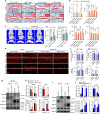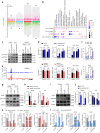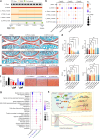LATS1-modulated ZBTB20 perturbing cartilage matrix homeostasis contributes to early-stage osteoarthritis
- PMID: 40069162
- PMCID: PMC11897192
- DOI: 10.1038/s41413-025-00414-3
LATS1-modulated ZBTB20 perturbing cartilage matrix homeostasis contributes to early-stage osteoarthritis
Abstract
Osteoarthritis (OA) is one of the most common degenerative joint diseases in the elderly, increasing in prevalence and posing a substantial socioeconomic challenge, while no disease-modifying treatments available. Better understanding of the early molecular events will benefit the early-stage diagnosis and clinical therapy. Here, we observed the nucleus accumulation of ZBTB20, a member of ZBTB-protein family, in the chondrocytes of early-stage OA. Chondrocytes-specific depletion of Zbtb20 in adult mice attenuated DMM-induced OA progress, restored the balance of extracellular matrix anabolism and catabolism. The NF-κB signaling mediated disturbance of ECM maintenance by ZBTB20 requires its suppression of Pten and consequent PI3K-Akt signaling activation. Furthermore, the subcellular localization of ZBTB20 was modulated by the kinase LATS1. Independent approaches to modulating ZBTB20 via utilizing TRULI and DAPA can restore ECM homeostasis, improving the abnormal behavior and moderating cartilage degeneration. The compounds TRULI and DAPA modulating ZBTB20 may serve as anti-OA drugs.
© 2025. The Author(s).
Conflict of interest statement
Competing interests: The authors declare no competing interests.
Figures






References
-
- Hunter, D. J. & Bierma-Zeinstra, S. Osteoarthritis. Lancet393, 1745–1759 (2019). - PubMed
-
- Salmon, J. H. et al. Economic impact of lower-limb osteoarthritis worldwide: a systematic review of cost-of-illness studies. Osteoarthr. Cartil.24, 1500–1508 (2016). - PubMed
-
- Sharma, L. Osteoarthritis of the Knee. N. Engl. J. Med.384, 51–59 (2021). - PubMed
-
- Mahmoudian, A., Lohmander, L. S., Mobasheri, A., Englund, M. & Luyten, F. P. Early-stage symptomatic osteoarthritis of the knee - time for action. Nat. Rev. Rheumatol.17, 621–632 (2021). - PubMed
MeSH terms
Substances
Grants and funding
LinkOut - more resources
Full Text Sources
Medical
Research Materials

